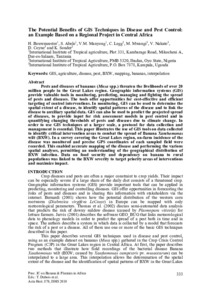| dc.contributor.author | Manyong, Victor M. |
| dc.contributor.author | Legg, C. |
| dc.contributor.author | Mwangi, M. |
| dc.contributor.author | Nakato, V. |
| dc.contributor.author | Coyne, D.L. |
| dc.contributor.author | Sonder, Kai |
| dc.contributor.author | Abele, S. |
| dc.date.accessioned | 2019-12-04T11:14:07Z |
| dc.date.available | 2019-12-04T11:14:07Z |
| dc.date.issued | 2010-11 |
| dc.identifier.citation | Manyong, V.M., Legg, C., Mwangi, M., Nakato, V., Coyne, D., Sonder, K., ... & Abele, S. (2008). The potential benefits of GIS techniques in disease and pest control: an example based on a regional project in Central Africa. In IV International Symposium on Banana: International Conference on Banana and Plantain in Africa. Acta Horticulturae, 879, 333-340. |
| dc.identifier.issn | 0567-7572 |
| dc.identifier.uri | https://hdl.handle.net/20.500.12478/2651 |
| dc.description.abstract | Pests and diseases of bananas (Musa spp.) threaten the livelihoods of over 20million people in the Great Lakes region. Geographic information systems (GIS)provide valuable tools in monitoring, predicting, managing and fighting the spreadof pests and diseases. The tools offer opportunities for cost-effective and efficienttargeting of control interventions. In monitoring, GIS can be used to determine thespatial extent of a disease, to identify spatial patterns of the disease and to link thedisease to auxiliary spatial data. GIS can also be used to predict the projected spreadof diseases, to provide input for risk assessment models in pest control and inquantifying changing thresholds of pests and diseases due to climate change. Inorder to use GIS techniques at a larger scale, a protocol for data collection andmanagement is essential. This paper illustrates the use of GIS tools on data collectedto identify critical intervention areas to combat the spread of Banana Xanthomonaswilt (BXW). In a survey covering the Great Lakes region, on-farm incidence of thedisease was monitored and precise GPS coordinates of each sampled field wererecorded. This enabled accurate mapping of the disease and performing the variousspatial analyses, permitting an understanding of the geographical distribution ofBXW infection. Data on food security and dependency on banana to ruralpopulations was linked to the BXW severity to target priority areas of interventionsand maximize impact. |
| dc.format.extent | 333-340 |
| dc.language.iso | en |
| dc.subject | Gis |
| dc.subject | Agriculture |
| dc.subject | Diseases |
| dc.subject | Pests |
| dc.subject | Bxw |
| dc.subject | Mapping |
| dc.subject | Bananas |
| dc.subject | Interpolation |
| dc.title | The potential benefits of GIS techniques in disease and pest control: an example based on a regional project in Central Africa |
| dc.type | Journal Article |
| dc.description.version | Peer Review |
| cg.contributor.affiliation | International Institute of Tropical Agriculture |
| cg.coverage.region | Africa |
| cg.coverage.region | East Africa |
| cg.coverage.country | Uganda |
| cg.authorship.types | CGIAR single centre |
| cg.iitasubject | Banana |
| cg.iitasubject | Plant Diseases |
| cg.iitasubject | Pest Of Plant |
| cg.journal | Acta Horticulturae |
| cg.howpublished | Formally Published |
| cg.accessibilitystatus | Limited Access |
| local.dspaceid | 93456 |
| cg.targetaudience | Scientists |
| cg.identifier.doi | https://doi.org/10.17660/ActaHortic.2010.879.34 |

